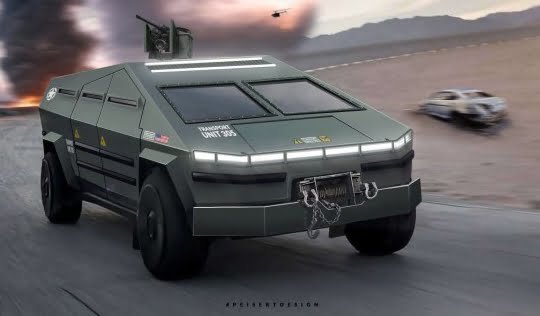Tesla’s Cybertruck has ignited a paradigm shift in the automotive industry with its bold design and innovative features.
As the electric vehicle (EV) market continues to expand, the Cybertruck stands out as a symbol of Tesla’s commitment to pushing the boundaries of conventional vehicle design.
This article explores the distinctive features of the Tesla Cybertruck and delves into the potential implications for auto insurance in the evolving landscape of electric vehicles.

Unconventional Design Elements:
Stainless Steel Exoskeleton: The most striking aspect of the Cybertruck is its exoskeleton, made from ultra-hard 30X cold-rolled stainless steel.
This design choice not only gives the vehicle an edgy, futuristic appearance but also enhances its durability.
The exoskeleton is dent-resistant, offering a departure from the typical wear and tear associated with traditional truck designs. Insurers may need to reconsider repair costs and coverage structures for this unique material.
Armor Glass: Tesla introduced “Armor Glass” for the Cybertruck’s windows, designed to be robust and shatterproof.
While the attempt to create resilient glass is commendable, the real-world implications for insurance come into play.
The durability of the armor glass affects not only the safety of the vehicle but also the potential costs associated with repairs. Insurers must assess how these unique materials impact the overall risk profile of the Cybertruck.
Electric Power and Performance:
All-Electric Powertrain: The Cybertruck, like other Tesla vehicles, is fully electric, marking a shift away from traditional combustion engines.
The electric powertrain not only contributes to a reduced carbon footprint but also alters the vehicle’s maintenance needs.
Insurers may view this positively, potentially resulting in adjusted premiums to reflect the lower likelihood of mechanical failures associated with electric vehicles.
Impressive Performance Metrics: With powerful acceleration and an extended electric range, the Cybertruck delivers an impressive performance that is characteristic of Tesla’s electric lineup.
The enhanced performance capabilities may influence driving behavior, potentially impacting the frequency and severity of accidents.
Insurers need to consider these factors when assessing risk and setting premiums for Cybertruck owners.
Autonomous Driving Capabilities:Integration of Autopilot: Tesla’s advanced driver-assistance system, Autopilot, is a key feature in the Cybertruck.
While full autonomy is still a work in progress, the inclusion of autonomous driving features raises questions about liability in the case of accidents.
As autonomous technology continues to evolve, insurers must stay adaptable and update policies to address the shifting landscape of self-driving vehicles.
Implications for Auto Insurance:
Repair Costs and Specialized Materials: The use of unconventional materials in the Cybertruck, such as the stainless steel exoskeleton and armor glass, presents a unique challenge for insurers in estimating repair costs.
Traditional repair processes and materials may not apply directly, potentially impacting repair expenses and, consequently, insurance premiums.
Insurers may need to develop specialized coverage models to align with the distinctive features of the Cybertruck.
Safety Features and Premiums: The Cybertruck’s innovative safety features, including the robust exoskeleton and armor glass, offer an opportunity for insurers to reassess premiums. Enhanced safety measures can potentially reduce the risk of accidents,
leading to lower insurance costs for Cybertruck owners. As safety technology continues to advance, insurers must stay ahead in evaluating and adapting their coverage structures.
Autonomous Technology Challenges: The inclusion of autonomous driving features in the Cybertruck introduces unique challenges for insurers in determining liability.
As regulations surrounding autonomous vehicles evolve, insurers need to carefully navigate the complexities associated with self-driving technology. This includes understanding the level of autonomy, training protocols, and the potential impact on accident patterns.
The Tesla Cybertruck, with its groundbreaking design and innovative features, is reshaping perceptions of what a pickup truck can be.
As it enters the automotive landscape, insurers face the task of adapting to its unconventional materials, safety features, and evolving technologies. From the robust exoskeleton to the integration of autonomous driving capabilities, the Cybertruck introduces distinctive considerations for auto insurance.
Insurers must navigate this new terrain, ensuring that coverage and premiums align with the unique features and developments associated with the Cybertruck. As Tesla continues to pioneer advancements in electric vehicles, insurers play a crucial role in supporting the seamless integration of these cutting-edge vehicles into the broader automotive insurance landscape.
Наиболее трендовые новинки моды.
Исчерпывающие эвенты лучших подуимов.
Модные дома, торговые марки, гедонизм.
Новое место для модных людей.
https://ullafashion.ru/
https://ullafashion.ru/
Несомненно актуальные события индустрии.
Исчерпывающие события лучших подуимов.
Модные дома, бренды, haute couture.
Самое лучшее место для модных хайпбистов.
https://balmain1.ru/
https://balmain1.ru/
Наиболее стильные события подиума.
Важные события самых влиятельных подуимов.
Модные дома, бренды, haute couture.
Лучшее место для стильныех людей.
https://superlooks.ru/
https://superlooks.ru/
Точно трендовые новинки мировых подиумов.
Исчерпывающие мероприятия всемирных подуимов.
Модные дома, торговые марки, гедонизм.
Лучшее место для трендовых людей.
https://superlooks.ru/
https://superlooks.ru/
Несомненно актуальные события индустрии.
Абсолютно все мероприятия всемирных подуимов.
Модные дома, торговые марки, haute couture.
Лучшее место для трендовых людей.
https://metamoda.ru/
https://metamoda.ru/
Абсолютно стильные события моды.
Актуальные события известнейших подуимов.
Модные дома, лейблы, высокая мода.
Свежее место для модных людей.
https://femalemoda.ru/